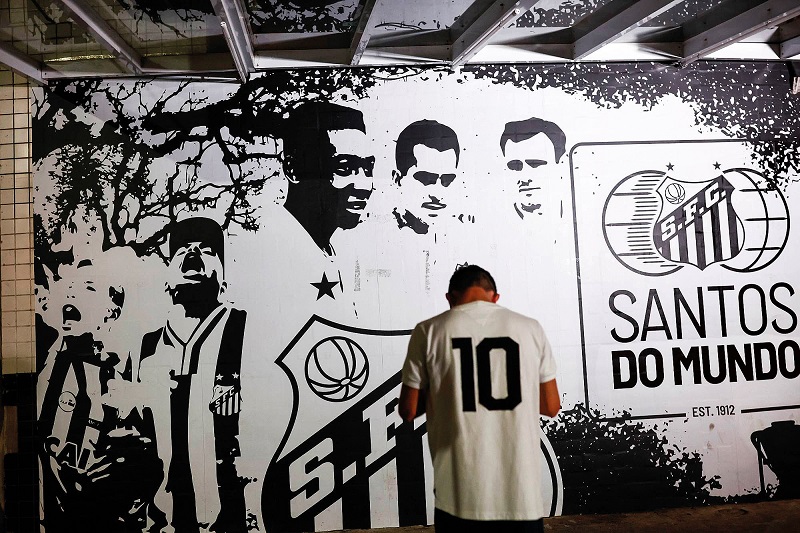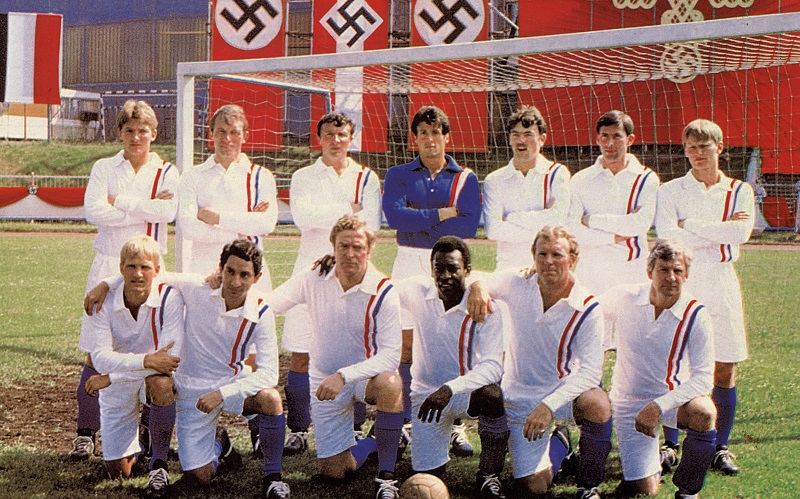
Sportswriter Hugh McIlvanney described him best when he wrote: “His relationship with the ball was different from that achieved by anyone else." (Photo: Bloomberg)
Football is crying. “Even the sky is crying,” a Brazilian newspaper claimed after it poured during Pelé’s last game. That was half a century ago, and the tears are flowing again for the shoeshine boy who shone like a supernova.
More than a week since his passing and into a new year, the game is still mourning its king, still lauding him, and in some quarters, still debating his place in history.
A gilded podium at football’s loftiest peak is not in question, but there are those who say Pelé should share it with one or possibly two Argentinians, and even quibble about the pecking order.
We wouldn’t be human if we didn’t try to cut even our tallest poppies down to size. And that’s just on the field. Off it is a different story: Pelé spent a long time retired and a kind verdict on his post-playing career is that it was chequered.
In business, he found the tackles harder to ride. He misplaced passes and lost possession (of two fortunes and two wives). And he scored a few own goals. There was a string of extramarital affairs, and he denied paternity of a daughter he outlived.
As he stumbled, his stock fell and he was even ridiculed. In Brazil, his approval rating was never as unanimous as it was around the globe. That characters as diverse as Mane Garrincha and Ayrton Senna could top him in popularity polls says a lot. But what hurt most came after he had stopped playing — retrospective insinuations that he was an Uncle Tom.
np_file_202581.jpeg

Unlike Muhammad Ali, his only rival as a sporting demigod, he chose not to use his influence against the white establishment. Back then, for much of his time, Brazil was a military government. And yet the outpouring of grief, which shows no sign of abating, suggests he is still loved in his homeland every bit as much as, if not more than, the boxer is in the US.
As a footballer, he was as close to perfect as it gets. Lionel Messi and Diego Maradona used their right legs only for standing on, but Pelé could launch rockets or play the violin with either foot. Just over an inch (2.5cm) taller than Messi’s 5ft 7in (1.7m), he was built like a pocket battleship to the latter’s light cruiser.
Nor did he need Maradona’s ungodly hand in the air. He could run the 100m in 11 seconds while, with the ball seemingly stuck like Velcro to his feet, he simply flowed. Altogether, he scored a staggering 1,283 goals in 1,363 matches.
Sportswriter Hugh McIlvanney described him best when he wrote: “His relationship with the ball was different from that achieved by anyone else. Other great footballers concentrated on mastering the ball and using it as a tool. For him, it often seemed a living ally, dancing between and around his sprinting feet as if it chose to be there.”
On a run, he was a wondrous sight, and this was when pitches were like paddy fields and defenders were allowed to get away with murderous tackles. Hatchet men would sharpen their blades to chop down superstars, as Maradona would discover as the victim of the infamous “Butcher of Bilbao”, Andoni Goikoetxea.
To protect Pelé, Brazil’s congress declared him a “national treasure”, barring him from moving abroad. But there was a loophole. His club Santos had to tour Europe to make ends meet, and host clubs always insisted that Pelé played. And so, he was still at the mercy of medieval trophy hunters.
-1x-1.jpg

Not that he was a shrinking violet. He was sent off three times during his career. But once in Bogota, Colombia, in 1969, the crowd erupted, demanding his return. Amid the pandemonium, it was decided that the only way to avoid a full-scale riot was for Pelé to return to the field and have the referee changed. In the end, it was the referee who was sent off!
In 1973, after being kicked all around Europe, he found himself in Plymouth, England. Dismayed at his treatment and disgusted with the referees, he pleaded with his designated marker: “Go easy on me.” The marker did and was rewarded with Pelé’s shirt. And I write this from personal experience, having been there at the game.
I saw every game he played in the 1970 World Cup and couldn’t get enough of him. That, in fact, was the tournament that sealed his legacy as the game’s first superstar, football’s very own Elvis. On the eve of the final, Italy defender Tarcisio Burgnich kept telling himself: “He’s only flesh and blood just like me.” After the game, he said: “I was wrong.”
Pelé would continue to play with Santos for three more years but quit international football and wanted one last hurrah that paid well. The world was literally at his incomparable feet. North American Soccer League (NASL) boss Clive Toye offered him US$7 million and told him: “You could go to Italy or Spain and win a championship. But if you come to us, you can win a country.” He took the money and the challenge.
In 2½ seasons, he raised New York Cosmos home crowds from an average of 3,500 to 40,000 and paved the way for the US to host the 1994 World Cup. A new audience and new converts for the new messiah. Soon after he left, the league folded, even with disciples the calibre of George Best, Johan Cruyff and Franz Beckenbauer. It really was all down to Pelé.
1200x-1.jpg

But the enormous credit he had amassed on the field was no use against financial losses, although it ensured he remained one of the 20th century’s most influential figures — and is being remembered well into the 21st. Andy Warhol may have been right when he said, “Pelé is one of the few who contradicted my theory: Instead of 15 minutes of fame, he will have 15 centuries.”
He was often compared to Ali, who was two years younger, as their stellar careers ran concurrently and peaked with the arrival of colour television. Indeed, they were so ubiquitous, you almost felt each man had a double, especially as they had alternative names: one for the younger sporting god and the other, the flawed older man fumbling in a less familiar role.
While Ali morphed from Cassius Clay, a loudmouth light-heavyweight, to a Black Muslim preacher while still boxing, Pelé remained very much Pelé to football and the outside world. But first as a businessman and later as sports minister in Brazil, he was known by his proper name of Edson Arantes do Nascimento.
His 1970 World Cup winning teammate turned pundit Rivellino explained the difference: “It’s important to stress that Pelé is one thing and Edson is another. He had several problems off the field and could not serve as an example for anyone.” Brazilian great Romario was more succinct when he said, “Pelé is a poet … when he has his mouth shut.”
The official name was indeed a mouthful and it is hard to imagine his fame catching on as quickly or lasting as long as the universally popular “Pelé”. Easy to say and impossible to forget, Pelé was declared the most famous person in the world in 1970 — above even Ali.
And their names told starkly different stories. Where Ali stood against the US government by avoiding the draft for the Vietnam War, Pelé was accused of acquiescing to Brazil’s junta. He strongly refuted this, and his critics ignore the fact that he and most of his teammates never saw a problem anyway.
telemmglpict000227936270_trans_nvbqzqnjv4bq8asj1ehb3tspqqwok7bwe84u-mtrxka_xghjlccmo8m.jpeg

On his first overseas trip to Sweden as a 17-year-old for the 1958 World Cup, he did ask, “Are we the only team with blacks in it?” But that was as far as his racial awareness went. “I try to serve as a good example,” he would always claim. “That’s my position against racism.”
And that from a man whose great-grandma was a slave. Like much of the world, he still called Ali “Cassius” years after the American dropped what he dubbed his “slave” name. It might seem a submissive stance in today’s woke era, but Pelé was actually a trailblazer for his nation as well as his race — through football.
A nine-year-old Pelé cried after host Brazil’s catastrophic loss to Uruguay in the 1950 World Cup and vowed to make amends. And it was tears of joy that he shed eight years later when Brazil won and he announced himself to the world.
At the turn of the millennium, he was voted World Player of the Century by the International Federation of Football Historians and Statisticians. In 1999, the International Olympic Committee elected him the Athlete of the Century and Time magazine named him one of the 100 Most Important People of the 20th Century.
We should stop crying and start celebrating a player who reached for — and touched — the stars. Eighty-two is decent innings given the life he led and better than par for where he came from. His mother, Celeste, a cart-driver’s daughter, was 16 when she gave birth to him in a shanty town called Tres Coracoes (Three Hearts), south of Rio. His father Donadinho was a promising footballer. They named him after Thomas Edison as electricity had only just come to their town. They misspelt the inventor’s name, but you could still say it was a lightbulb moment. Mum, 98, is still alive but has not been told of her son’s death.
He certainly set an example. He was nowhere near as perfect off the field as he was on it, but he was not only an inspiration to the great unwashed, he was also in demand by high-flyers too — he signed his autograph for 70 presidents, five kings, 10 emperors and two popes.
When they buried him, I just hope they did so with a football, for he was never the same without “his living ally”.
This article first appeared on Jan 9, 2022 in The Edge Malaysia.


